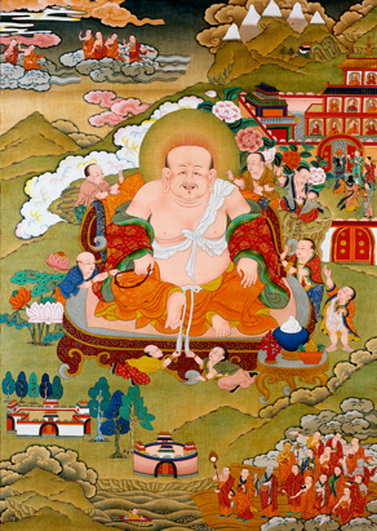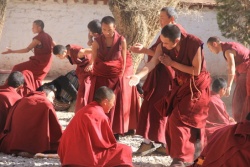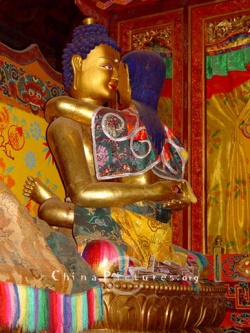Difference between revisions of "Hva Shang"
| Line 1: | Line 1: | ||
[[Image:Hva_Shang.jpg|frame|'''Hva Shang''']] | [[Image:Hva_Shang.jpg|frame|'''Hva Shang''']] | ||
| − | '''Hva Shang''' (Tib. [[Hashang]]) - attendant of the [[Sixteen Arhats]] | + | '''[[Hva Shang]]''' (Tib. [[Hashang]]) - attendant of the [[Sixteen Arhats]] |
| − | Hva Shang, meaning ‘a Chinese | + | [[Hva Shang]], meaning ‘a {{Wiki|Chinese}} [[monk]]’, was sent by [[Emperor]] T’ai-tsung of [[China]] with an elegently worded [[letter]] to invite the [[Sixteen Arhats]] to [[China]]. He accompanied them as they travelled to [[China]] where they observed the three Months’ [[Rains Retreat]] and [[taught]] extensively from the [[three pitakas]], the three collections or '[[baskets]]' into which the [[Word of the Buddha]] is divided. They are [[Vinaya]], [[Sutra]] and [[Abhidharma]]. |
{{RigpaWiki}} | {{RigpaWiki}} | ||
| + | |||
{{NewSourceBreak}} | {{NewSourceBreak}} | ||
| Line 29: | Line 30: | ||
Most of what is known of [[Moheyan’s teaching]] comes from fragments of writings in {{Wiki|Chinese}} and [[Tibetan]] found in the [[Mogao caves]] at [[Dunhuang]], {{Wiki|Gansu}}, {{Wiki|China}}. The {{Wiki|manuscript}} given the appellation IOL Tib J 709 is a collection of nine [[Chan texts]], commencing with the teachings of [[Moheyan]]. | Most of what is known of [[Moheyan’s teaching]] comes from fragments of writings in {{Wiki|Chinese}} and [[Tibetan]] found in the [[Mogao caves]] at [[Dunhuang]], {{Wiki|Gansu}}, {{Wiki|China}}. The {{Wiki|manuscript}} given the appellation IOL Tib J 709 is a collection of nine [[Chan texts]], commencing with the teachings of [[Moheyan]]. | ||
| − | [[Moheyan]] taught in the [[tradition]] of the “[[sudden enlightenment]]” and was affiliated with the [[East Mountain Teachings]]. The {{Wiki|dichotomy}} of the [[gradual]] {{Wiki|north}} and sudden {{Wiki|south}} is a historical construction as both Northern and Southern Schools contained '[[gradualist teachings]]' ({{Wiki|Chinese}}: [[tun-men]]) and '[[sudden teachings]]' ({{Wiki|Chinese}}: [[chien-men]]) and practices. [[Moheyan]] held that all [[thought]] ([[thinking]] and [[ideation]]) prevented [[enlightenment]]: “Not [[thinking]], not [[pondering]], non-examination, non-apprehension of an object---this is the immediate access [to [[liberation]]]." He also believed that carrying out good or [[evil]] acts leads to [[transmigration]] rather than [[liberation]] as these acts “lead to [[heaven]] or [[hell]].” | + | [[Moheyan]] [[taught]] in the [[tradition]] of the “[[sudden enlightenment]]” and was affiliated with the [[East Mountain Teachings]]. The {{Wiki|dichotomy}} of the [[gradual]] {{Wiki|north}} and sudden {{Wiki|south}} is a historical construction as both Northern and Southern Schools contained '[[gradualist teachings]]' ({{Wiki|Chinese}}: [[tun-men]]) and '[[sudden teachings]]' ({{Wiki|Chinese}}: [[chien-men]]) and practices. [[Moheyan]] held that all [[thought]] ([[thinking]] and [[ideation]]) prevented [[enlightenment]]: “Not [[thinking]], not [[pondering]], non-examination, non-apprehension of an object---this is the immediate access [to [[liberation]]]." He also believed that carrying out good or [[evil]] acts leads to [[transmigration]] rather than [[liberation]] as these acts “lead to [[heaven]] or [[hell]].” |
An important aspect of [[Moheyan’s]] [[teaching]] was that if all [[thought]], good or bad, obscures [[enlightenment]], then all [[actions]] must be based on the simplest {{Wiki|principles}} of conduct. To achieve [[proper conduct]], all conceptions, without exception should be seen as false: “If one sees conceptions as no {{Wiki|conception}}, one sees the [[Tathāgata]].” To rid oneself of all conceptions, one must [[practice]] [[meditation]], [[trance]], and contemplating the [[mind]]: “To turn the [[light]] [of the [[mind]]] towards the [[mind’s]] source, that is contemplating the [[mind]]. …one does not reflect on or observe whether [[thoughts]] are in {{Wiki|movement}} or not, whether they are [[pure]] or not, whether they are [[empty]] or not.” | An important aspect of [[Moheyan’s]] [[teaching]] was that if all [[thought]], good or bad, obscures [[enlightenment]], then all [[actions]] must be based on the simplest {{Wiki|principles}} of conduct. To achieve [[proper conduct]], all conceptions, without exception should be seen as false: “If one sees conceptions as no {{Wiki|conception}}, one sees the [[Tathāgata]].” To rid oneself of all conceptions, one must [[practice]] [[meditation]], [[trance]], and contemplating the [[mind]]: “To turn the [[light]] [of the [[mind]]] towards the [[mind’s]] source, that is contemplating the [[mind]]. …one does not reflect on or observe whether [[thoughts]] are in {{Wiki|movement}} or not, whether they are [[pure]] or not, whether they are [[empty]] or not.” | ||
| − | While [[Moheyan]] took a radical approach to the [[achievement]] of [[enlightenment]] (and defended it vigorously), his position was weakened when questioned by, and entering into [[debate]] with, those [[people]] who could not [[meditate]], who could not “turn the [[light]] of the [[mind]] towards the [[mind’s]] source.” He conceded that practices such as the “[[perfection]] of [[morality]]”, studying the [[sutras]] and teachings of the [[masters]] and [[cultivating]] [[meritorious]] [[actions]] were [[appropriate]]. These types of [[actions]] were seen as part of the “gradualist” school and [[Moheyan]] held that these were only necessary for those of "dim" facility and “dull” propensity. Those of “sharp” and "keen" facility and propensity do not need these practices as they have “direct” access to the [[truth]] through [[meditation]]. This concession to the “gradualists”, that not everyone can achieve the [[highest]] state of [[meditation]], left [[Moheyan]] open to attack on the basis of a [[dualistic]] approach to [[practice]]. To overcome these inconsistencies in his {{Wiki|thesis}}, [[Moheyan]] claimed that when one gave up all conceptions, an automatic, all-at-once [[attainment]] of [[virtue]] resulted. He taught that there was an “{{Wiki|internal}}” [[practice]] to {{Wiki|liberate}} the [[self]] (‘[[prajñā]]’ or [[wisdom]]) and an “{{Wiki|external}}” [[practice]] to {{Wiki|liberate}} others (‘[[upaya]]’, or [[expedient means]]). These were seen as two {{Wiki|independent}} practices, a concession to [[human]] {{Wiki|psychology}} and scriptural [[tradition]]. | + | While [[Moheyan]] took a radical approach to the [[achievement]] of [[enlightenment]] (and defended it vigorously), his position was weakened when questioned by, and entering into [[debate]] with, those [[people]] who could not [[meditate]], who could not “turn the [[light]] of the [[mind]] towards the [[mind’s]] source.” He conceded that practices such as the “[[perfection]] of [[morality]]”, studying the [[sutras]] and teachings of the [[masters]] and [[cultivating]] [[meritorious]] [[actions]] were [[appropriate]]. These types of [[actions]] were seen as part of the “gradualist” school and [[Moheyan]] held that these were only necessary for those of "dim" facility and “dull” {{Wiki|propensity}}. Those of “sharp” and "keen" facility and {{Wiki|propensity}} do not need these practices as they have “direct” access to the [[truth]] through [[meditation]]. This concession to the “gradualists”, that not everyone can achieve the [[highest]] state of [[meditation]], left [[Moheyan]] open to attack on the basis of a [[dualistic]] approach to [[practice]]. To overcome these inconsistencies in his {{Wiki|thesis}}, [[Moheyan]] claimed that when one gave up all conceptions, an automatic, all-at-once [[attainment]] of [[virtue]] resulted. He [[taught]] that there was an “{{Wiki|internal}}” [[practice]] to {{Wiki|liberate}} the [[self]] (‘[[prajñā]]’ or [[wisdom]]) and an “{{Wiki|external}}” [[practice]] to {{Wiki|liberate}} others (‘[[upaya]]’, or [[expedient means]]). These were seen as two {{Wiki|independent}} practices, a concession to [[human]] {{Wiki|psychology}} and [[scriptural]] [[tradition]]. |
Legacy | Legacy | ||
| Line 42: | Line 43: | ||
{{Wiki|Iconography}} | {{Wiki|Iconography}} | ||
| − | According to [[Ying | + | According to [[Ying Chua[[ (1998), [[Moheyan]] is often iconographically depicted holding a [[shankha]] ([[Sanskrit]]) and a [[mala]] ([[Sanskrit]]): |
He is usually depicted as a rotund and jovial figure and holding a [[mala]], or [[prayer]] beads in his left hand and a [[sankha]], [[conch shell]] in his right. He is often considered a benefactor of children and is usually depicted with at least one or more playing children around him. | He is usually depicted as a rotund and jovial figure and holding a [[mala]], or [[prayer]] beads in his left hand and a [[sankha]], [[conch shell]] in his right. He is often considered a benefactor of children and is usually depicted with at least one or more playing children around him. | ||
{{W}} | {{W}} | ||
| − | [[Category: | + | [[Category:Great Samyé Debate]] |
[[Category:Heshang Moheyan]] | [[Category:Heshang Moheyan]] | ||
[[Category:Sixteen Arhats]] | [[Category:Sixteen Arhats]] | ||
Revision as of 11:43, 4 August 2014
Hva Shang (Tib. Hashang) - attendant of the Sixteen Arhats
Hva Shang, meaning ‘a Chinese monk’, was sent by Emperor T’ai-tsung of China with an elegently worded letter to invite the Sixteen Arhats to China. He accompanied them as they travelled to China where they observed the three Months’ Rains Retreat and taught extensively from the three pitakas, the three collections or 'baskets' into which the Word of the Buddha is divided. They are Vinaya, Sutra and Abhidharma.
Source
<poem> Heshang Moheyan (和尚摩訶衍; Wade-Giles:Ho-shang Mo-ho-yen; Héshang Móhēyǎn or Hvashang Moheyan in Tibetan sources) was a late 8th century Chan monk associated with the Northern School and famous for representing Chan vs. Indian Buddhism in a debate that is supposed to have set the course of Tibetan Buddhism. Hva-shang is a Tibetan approximation of the Chinese hoshang, meaning monk. Hoshang in turn comes from the Sanskrit title upadhyaya.
An iconographic thangka depiction of Moheyan is held in the Southern Alleghenies Museum of Art (SAMA) collection, St. Francis College, Loretto, Pennsylvania.
Dunhuang sojourn
Whilst the East Mountain Teachings (pejoratively known as the "Northern School" Chan) were in decline, having been attacked by Heze Shenhui (a student of Dajian Huineng) as a supposed "gradual enlightenment" teaching, Moheyan traveled to Dunhuang, which at the time belonged to the Tibetan Empire, in 781 or 787. For Moheyan, this was a new opportunity for the spread of (Northern) Chan. Council of Lhasa
After teaching in the area of Dunhuang, Moheyan was invited by King Trisong Detsen of Tibet to settle at Samye Monastery, then the center of emerging Tibetan Buddhism. Moheyan promulgated a variety of Chan and disseminated teachings from Samye where he attracted a considerable number of followers.
However, in 793 Trisong Detsen resolved that Moheyan did not hold the true Dharma. Following intense protests from Moheyan’s supporters, Trisong Detsen proposed to settle the matter by sponsoring a debate: dialectic is an ancient aspect of the Indian and Chinese religions, as it is in Himalayan tradition. The most famous of these debates has become known as the "Council of Lhasa", although it may have taken place at Samye, a considerable distance from Lhasa. For the famed Council of Lhasa, an Indian monk named Kamalaśila was invited to represent Indian Buddhism, while Moheyan represented Northern School Chán and Chinese Buddhism. Most Tibetan sources state that the debate was decided in Kamasila’s favour (though many Chinese sources claim Moheyan won) and Moheyan was required to leave the country and that all sudden-enlightenment texts were gathered and destroyed by royal decree. This was a pivotal event in the history of Tibetan Buddhism, which would afterward continue to follow the late Indian model with only minor influence from China. Moheyan’s teachings were a mixture of the 'East Mountain Teachings' Chinese: 東山法門 tung-shan fa-men; given the appellation of "Northern School" Chan by Shenhui (670-762)} associated with Shenxiu and Baotang Chán.
Broughton (1983: p. 9) identifies the Chinese and Tibetan nomenclature of Mohoyen's teachings and identifies them principally with the East Mountain Teachings:
Mo-ho-yen's teaching in Tibet as the famed proponent of the all-at-once gate can be summarized as "gazing-at-mind" (Chinese: k'an-hsin... = Tibetan:] sems la bltas) and "no examining" (Chinese: pu-kuan... = Tibetan:] myi rtog pa) or "no-thought no-examining" (Chinese:
pu-ssu pu-kuan... = Tibetan: myi bsam myi rtog). "Gazing-at-mind" is an original Northern (or East Mountain Dharma Gate) teaching. As will become clear, Poa-t'ang and the Northern Ch'an dovetail in the Tibetan sources. Mo-ho-yen's teaching seems typical of late Northern Ch'an. It should be noted that Mo-ho-yen arrived on the central Tibetan scene somewhat late in comparison to the Ch'an transmissions from Szechwan.
Most of what is known of Moheyan’s teaching comes from fragments of writings in Chinese and Tibetan found in the Mogao caves at Dunhuang, Gansu, China. The manuscript given the appellation IOL Tib J 709 is a collection of nine Chan texts, commencing with the teachings of Moheyan.
Moheyan taught in the tradition of the “sudden enlightenment” and was affiliated with the East Mountain Teachings. The dichotomy of the gradual north and sudden south is a historical construction as both Northern and Southern Schools contained 'gradualist teachings' (Chinese: tun-men) and 'sudden teachings' (Chinese: chien-men) and practices. Moheyan held that all thought (thinking and ideation) prevented enlightenment: “Not thinking, not pondering, non-examination, non-apprehension of an object---this is the immediate access [to liberation]." He also believed that carrying out good or evil acts leads to transmigration rather than liberation as these acts “lead to heaven or hell.”
An important aspect of Moheyan’s teaching was that if all thought, good or bad, obscures enlightenment, then all actions must be based on the simplest principles of conduct. To achieve proper conduct, all conceptions, without exception should be seen as false: “If one sees conceptions as no conception, one sees the Tathāgata.” To rid oneself of all conceptions, one must practice meditation, trance, and contemplating the mind: “To turn the light [of the mind] towards the mind’s source, that is contemplating the mind. …one does not reflect on or observe whether thoughts are in movement or not, whether they are pure or not, whether they are empty or not.”
While Moheyan took a radical approach to the achievement of enlightenment (and defended it vigorously), his position was weakened when questioned by, and entering into debate with, those people who could not meditate, who could not “turn the light of the mind towards the mind’s source.” He conceded that practices such as the “perfection of morality”, studying the sutras and teachings of the masters and cultivating meritorious actions were appropriate. These types of actions were seen as part of the “gradualist” school and Moheyan held that these were only necessary for those of "dim" facility and “dull” propensity. Those of “sharp” and "keen" facility and propensity do not need these practices as they have “direct” access to the truth through meditation. This concession to the “gradualists”, that not everyone can achieve the highest state of meditation, left Moheyan open to attack on the basis of a dualistic approach to practice. To overcome these inconsistencies in his thesis, Moheyan claimed that when one gave up all conceptions, an automatic, all-at-once attainment of virtue resulted. He taught that there was an “internal” practice to liberate the self (‘prajñā’ or wisdom) and an “external” practice to liberate others (‘upaya’, or expedient means). These were seen as two independent practices, a concession to human psychology and scriptural tradition.
Legacy
The teachings of Moheyan and other Chan masters were unified with the Kham Dzogchen lineages {this may or may not be congruent with the Kahma (Tibetan: bka' ma) lineages} through the Kunkhyen (Tibetan for "omniscient"), Rongzom Chokyi Zangpo.
The Dzogchen ("Great Perfection") School of the Nyingmapa was often identified with the 'sudden enlightenment' (Tibetan: cig car gyi ‘jug pa) of Moheyan and was called to defend itself against this charge by avowed members of the Sarma lineages that held to the staunch view of 'gradual enlightenmnent' (Tibetan: rim gyis ‘jug pa). Iconography
According to [[Ying Chua[[ (1998), Moheyan is often iconographically depicted holding a shankha (Sanskrit) and a mala (Sanskrit):
He is usually depicted as a rotund and jovial figure and holding a mala, or prayer beads in his left hand and a sankha, conch shell in his right. He is often considered a benefactor of children and is usually depicted with at least one or more playing children around him.


